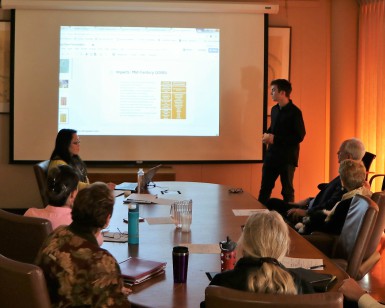San Rafael, CA – In Marin County, some of the best ideas about adapting to impending sea-level rise are coming from young people who will be confronted with the effects of climate change long after today’s decision-makers are gone.
 Zachary Baum of Marin Academy makes his presentation about sea-level rise adaptation.
Zachary Baum of Marin Academy makes his presentation about sea-level rise adaptation.
Marin Academy seniors presented projects about sea-level rise (SLR) to the
Marin Bay Waterfront Adaptation and Vulnerability Evaluation (BayWAVE) Executive Steering Committee on November 21.
Zachary Baum of Ross is conducting his two-year independent research project as part of the Marin Academy Research Collaborative. “I’m trying to shift the focus of sea-level rise from a scientific issue to a social issue,” he told the BayWAVE Executive Steering Committee.
Baum’s primary research includes a survey of residents along Marin’s entire bayside shoreline. Marin’s 2017 Bayside Vulnerability Report “provided great statistics on the economic impacts, but we need to figure out what that means for people living here,” he said.
He first asked questions on respondents’ demographics (race, income, home ownership) and then about their concerns on sea-level rise, trying to determine if there is a correlation between demographic factors and such concerns. Baum said he hopes his data can increase understanding of how the public interacts with vulnerable places and inform future adaptation priorities in Marin.
The Executive Steering Committee offered to help circulate Baum’s survey, which will be released in January 2018, through local newsletters and distribution lists. Residents who would like to take the survey may subscribe to the County’s SLR program email list at marinSLR.org.
“It’s a great project, and we’ll be really interested in the data,” said District 3 Supervisor Kate Sears, who represents much of Southern Marin.
Another project by Skye Hawthorne of Fairfax and Nicole De Petris of San Francisco focused on San Rafael’s Canal area. They chose the location because it is underserved, densely populated, and has a high poverty rate. Right at sea level, the neighborhood is incredibly susceptible and often ignored in adaptation, compared to wealthier areas. The students overviewed costs and benefits of various adaptation strategies, included elevation, armoring, relocation and nature-based. They concluded that nature-based solutions such as horizontal levees should be prioritized because of the public benefits.
The students’ instructor, Stori Oates, has integrated SLR lessons into her environmental education curriculum, including the County’s award-winning Game of Floods board game, which initially introduced students to some of those concepts.
The Marin Shoreline SLR Vulnerability Assessment, released in April 2017 as part of the BayWAVE project, uses the best available scientific data to identify specific risks for the region and the potential scope of flooding. A source for adaptation efforts, the report depicts the significant impact that rising waters will have on landscape and infrastructure in the coming years including to streets, highways, public transportation systems, wastewater treatment systems, emergency response services, and marsh habitats. Early estimates are that Marin can expect gradual losses of $8.5 billion worth of buildings and property through long-term SLR.
The 163-year-old Golden Gate tide gauge, the oldest continually operating gauge on the West Coast, has shown an eight-inch increase in SLR over the past century. By the end of the 21st century, water levels on Marin’s bay shoreline may be around five feet higher than what they are today, according to state level scientific guidance. As a coastal peninsula, Marin is extremely vulnerable to SLR and widespread impacts are likely.
The BayWAVE project is a comprehensive look at SLR for the communities of eastern Marin, which, for some areas along San Francisco Bay and San Pablo Bay is already an issue in the form of seasonal and tidal flooding. While a countywide response has begun, coordinated, collaborative efforts will be necessary to address the rising tides. The project is led by the County’s Community Development Agency (CDA) and Department of Public Works (DPW), which have worked to coordinate information and build partnerships with all 11 cities and towns in Marin as well as local and regional agencies. BayWAVE began in 2015 with $250,000 in funding from the California Coastal Conservancy’s Climate Ready grant program.
The commitment to environmental preservation is a top priority for the County of Marin. More information on this topic and related programs can be found on the County’s SLR website.